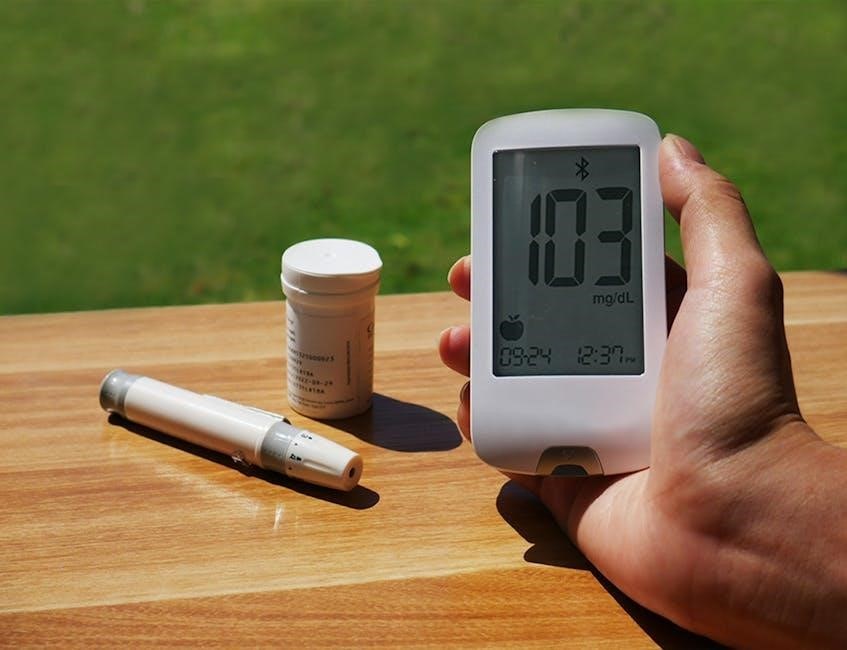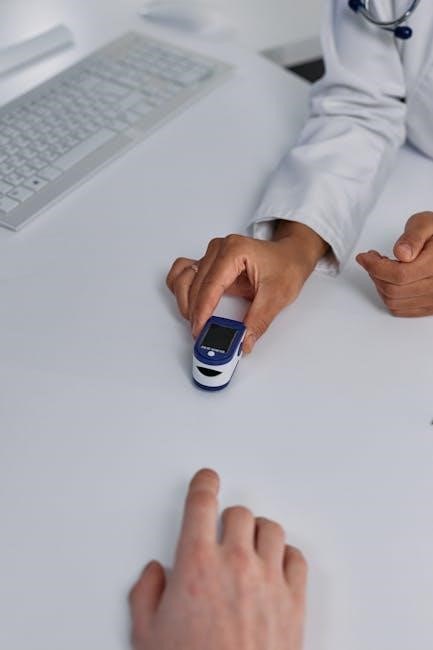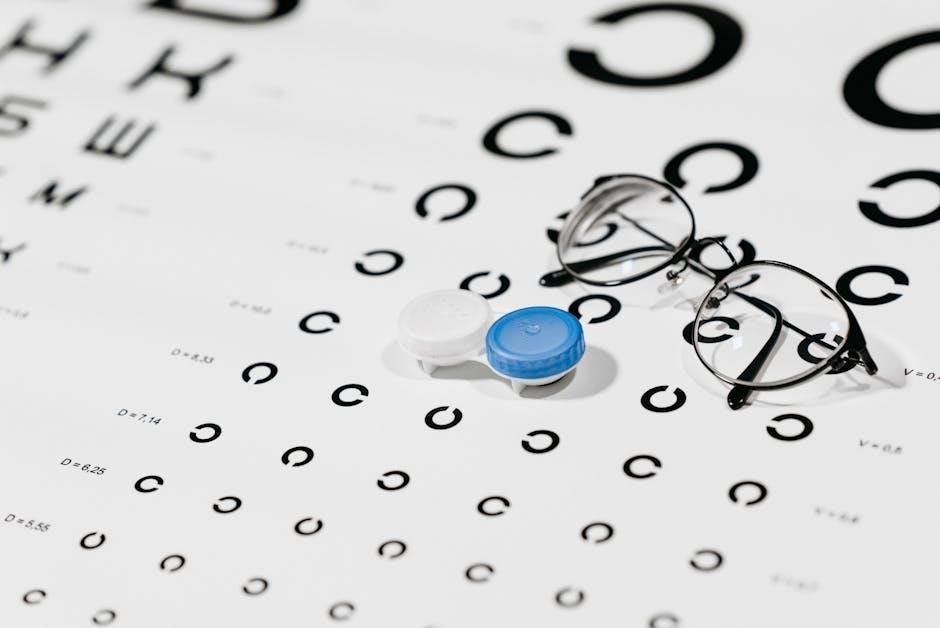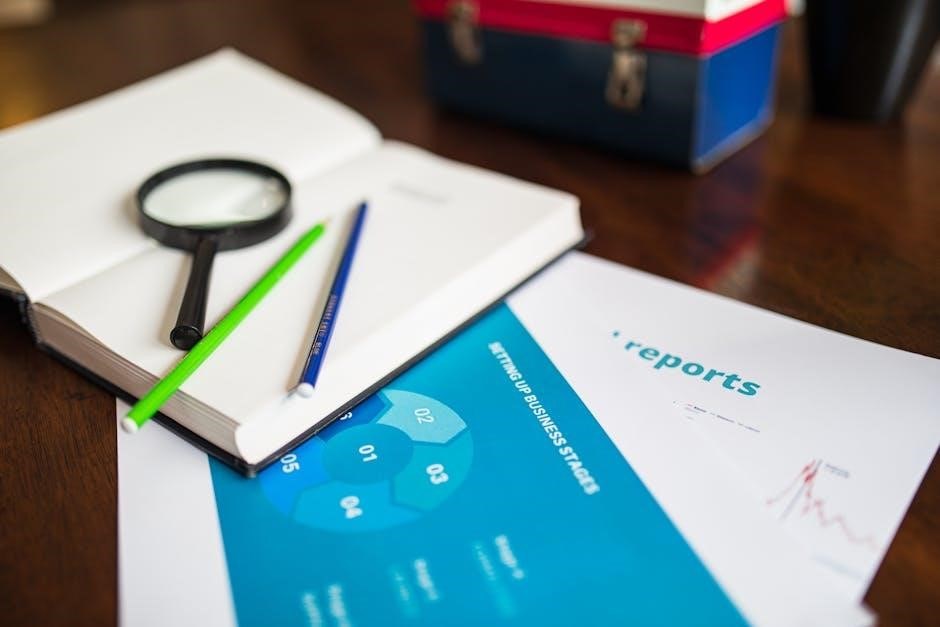Pulse oximetry is a non-invasive method to monitor oxygen saturation (SpO2) and heart rate. A pulse oximeter readings chart PDF helps track these vital signs, ensuring accurate health monitoring over time.

1.1 What is a Pulse Oximeter?
A pulse oximeter is a non-invasive medical device that measures oxygen saturation (SpO2) and heart rate. It uses light to detect changes in blood oxygen levels, providing real-time readings. A pulse oximeter readings chart PDF helps track these metrics, ensuring accurate monitoring over time. The device is clipped to a finger, toe, or earlobe, making it easy to use at home or in clinical settings. Regular use, avoiding interference like nail polish, ensures reliable results for better health management.
1.2 Importance of Pulse Oximeter Readings
Pulse oximeter readings are crucial for assessing oxygen saturation (SpO2) and heart rate, providing insights into respiratory and cardiovascular health. Monitoring these metrics helps detect hypoxemia early, guiding timely interventions. A pulse oximeter readings chart PDF allows individuals to track changes over time, enabling better health management. Regular use, especially for those with respiratory conditions, ensures early detection of desaturation, promoting proactive care and improving treatment outcomes. This non-invasive tool empowers individuals to monitor their health effectively at home.
Understanding Pulse Oximeter Readings
Pulse oximeter readings measure oxygen saturation (SpO2) and heart rate, providing vital insights into respiratory and cardiovascular health. A pulse oximeter readings chart PDF helps track these metrics over time, ensuring accurate monitoring and better health management.
2.1 SpO2 (Oxygen Saturation)
SpO2 measures oxygen saturation, the percentage of oxygen-carrying hemoglobin in the blood. Normal SpO2 levels range from 95% to 100%. Levels between 93%-94% may require medical evaluation, while below 91% indicates hypoxemia, potentially signaling serious health issues. A pulse oximeter readings chart PDF helps track SpO2 trends, enabling early detection of desaturation and guiding clinical decisions. Monitoring these levels regularly, especially for respiratory conditions, ensures timely interventions and improved health outcomes.
2.2 Pulse Rate (Heart Rate)
The pulse rate, measured in beats per minute (bpm), reflects heart activity. A normal adult range is 60-100 bpm. Elevated rates (tachycardia) or low rates (bradycardia) may signal health issues. A pulse oximeter readings chart PDF allows tracking of heart rate alongside SpO2, aiding in comprehensive health monitoring. This dual measurement is crucial for assessing overall cardiovascular and respiratory well-being, especially in conditions like sleep apnea or chronic respiratory diseases, where both metrics are vital for diagnosis and treatment planning.

Normal Pulse Oximeter Readings
Normal SpO2 levels range from 95-100%, while pulse rates typically fall between 60-100 bpm. Tracking these metrics with a pulse oximeter readings chart PDF ensures accurate monitoring and early detection of potential issues.

3.1 Normal SpO2 Levels for Adults
Normal SpO2 levels for adults typically range from 95% to 100%. Levels between 93%-94% may indicate mild desaturation, while readings below 91% are considered low and require medical attention. Using a pulse oximeter readings chart PDF helps track these levels, ensuring early detection of potential issues. Monitoring oxygen saturation regularly, especially for individuals with respiratory conditions, is crucial for maintaining health and preventing complications. Consistent tracking also aids in identifying trends and changes over time.
3.2 Normal SpO2 Levels for Children
For children, normal SpO2 levels typically range from 95% to 100%. Levels between 93%-94% may require monitoring, while readings below 91% indicate potential issues. Using a pulse oximeter readings chart PDF helps track oxygen levels in children, especially those with respiratory conditions. Regular monitoring ensures early detection of desaturation and supports timely interventions. Parents and caregivers can use these charts to maintain a record of their child’s oxygen levels, promoting better health management and peace of mind.
3.3 Normal SpO2 Levels for Newborns and Infants
For newborns and infants, normal SpO2 levels typically range from 95% to 100%. Levels below 95% may indicate potential respiratory issues. Monitoring oxygen levels regularly with a pulse oximeter is crucial, especially in the first few months of life. A pulse oximeter readings chart PDF can help track these levels, ensuring early detection of desaturation. Parents and caregivers can use these charts to maintain a record of their infant’s oxygen levels, supporting better health management and timely medical interventions if needed.
Interpreting Pulse Oximeter Readings
A pulse oximeter readings chart PDF helps interpret SpO2 and pulse rate, tracking trends over time. It aids in identifying normal, low, or high levels for timely medical interventions.
4.1 How to Read a Pulse Oximeter Chart
To read a pulse oximeter chart, identify the axes: time on the x-axis and SpO2 levels on the y-axis. Each data point represents a reading, with normal levels (95-100%) highlighted. Lower levels (below 95%) may indicate hypoxemia. Use the chart to track trends over time, ensuring readings stabilize before recording. Compare with baseline values to assess changes. This visual tool aids in monitoring oxygen levels and heart rate, helping detect patterns or abnormalities for timely interventions.
4.2 Clinical Significance of SpO2 Levels
SpO2 levels are crucial for assessing oxygenation status. Normal levels (95-100%) indicate adequate oxygenation, while readings below 95% may signal hypoxemia; Levels between 91-94% warrant monitoring, and below 91% require immediate medical attention. Tracking these levels over time helps identify trends, guiding treatment adjustments. This data is vital for diagnosing respiratory conditions, managing sleep apnea, and monitoring chronic diseases. Regular SpO2 monitoring ensures timely interventions, improving patient outcomes and preventing complications.
Abnormal Pulse Oximeter Readings
Abnormal readings include SpO2 below 95% (hypoxemia) or heart rate irregularities. Levels below 91% indicate severe hypoxemia, requiring immediate medical attention. High heart rates (tachycardia) may also signal distress.
5.1 Low SpO2 Levels (Hypoxemia)
Low SpO2 levels, or hypoxemia, occur when blood oxygen falls below 95%. Mild cases (91-94%) may require monitoring, while severe cases (below 91%) demand immediate medical attention. A pulse oximeter readings chart PDF helps track these levels, identifying trends and ensuring timely interventions. Hypoxemia can result from respiratory issues, sleep apnea, or other health conditions. Regular monitoring with a pulse oximeter and recording data in a chart is crucial for managing and preventing complications. Early detection is key to maintaining proper oxygenation and overall health.
5.2 High Heart Rate (Tachycardia)
A high heart rate, or tachycardia, is typically defined as a pulse exceeding 100 beats per minute. Pulse oximeter readings chart PDFs can help track heart rate alongside SpO2 levels, providing insights into overall health. Tachycardia may indicate stress, anxiety, or underlying medical conditions. Monitoring heart rate trends in a chart can aid in early detection of irregularities and guide medical decisions. Regular tracking ensures comprehensive health monitoring and timely interventions when necessary.

A pulse oximeter readings chart PDF is a structured tool for tracking oxygen levels and heart rate. It provides a clear, organized way to monitor progress over time.
6.1 How to Create a Pulse Oximeter Readings Chart
To create a pulse oximeter readings chart, include columns for date, time, SpO2 levels, and pulse rate. Add rows for daily or multiple readings. Start with patient information like name and baseline SpO2. Use an editable PDF template for easy customization. Ensure clarity and organization for accurate tracking. Download templates online or design one using spreadsheet software. Regular updates help monitor progress and identify trends in oxygen levels and heart rate over time.

6.2 Benefits of Using a PDF Chart for Tracking
A PDF chart for pulse oximeter readings offers clarity and structure, making it easy to monitor oxygen levels and heart rate over time. It allows for organized data entry, including date, time, and SpO2 values, enabling quick identification of trends. The chart is easily shareable with healthcare providers and accessible on multiple devices. Regular tracking promotes better health management and ensures timely interventions. Using a PDF chart also provides a professional and consistent format for maintaining accurate records.

Practical Tips for Accurate Readings
Ensure proper placement, avoid nail polish, and keep hands still. Use the oximeter three times daily for consistent tracking, and record results in your PDF chart for clarity.
7.1 Proper Placement of the Pulse Oximeter
Place the pulse oximeter on the fingertip, ensuring a snug fit without pressure. Avoid nail polish or false nails, as they can interfere with readings. The sensor should face upward for easy viewing. Keep the hand still and warm to ensure accurate results. Proper placement is crucial for obtaining reliable SpO2 and heart rate measurements. For alternative sites, the earlobe or toe in infants may be used. Always follow the manufacturer’s guidelines for optimal positioning.
7.2 Avoiding Interference (Nail Polish, Movement)
Avoid using nail polish or false nails, as they can block light and affect accuracy. Keep the hand still and avoid movement during measurement; Environmental factors like bright light or electrical interference should also be minimized. Ensure the sensor is not too tight or loose. For accurate readings, wait until the display stabilizes. Tracking progress with a pulse oximeter readings chart PDF helps identify consistent interference patterns and improves monitoring efficiency over time.
Monitoring Oxygen Levels at Home
Regularly track your oxygen levels using a pulse oximeter and record readings in a pulse oximeter readings chart PDF to monitor progress and ensure consistent health monitoring.
8.1 How to Monitor Oxygen Levels Daily
Use a pulse oximeter 3 times daily, ensuring proper placement and avoiding interference like nail polish. Keep your hand still, breathe normally, and record readings in a pulse oximeter readings chart PDF. Track your SpO2 and heart rate to identify trends. Share the data with your healthcare provider for personalized advice. Regular monitoring helps detect changes early, promoting better health management and timely interventions when needed.
8.2 Tracking Progress with a Pulse Oximeter Chart
A pulse oximeter readings chart PDF provides a clear, structured way to monitor oxygen levels and heart rate over time. Record SpO2, pulse, and date for each reading. This helps identify trends and changes, ensuring early detection of potential issues. Regular tracking allows healthcare providers to assess progress and adjust treatment plans. The chart also serves as a valuable tool for patients to stay informed and proactive about their health, promoting better management of respiratory and cardiovascular conditions.
Special Considerations
Pulse oximetry is crucial in managing sleep apnea and respiratory conditions. It helps monitor oxygen levels during sleep and track progress in chronic respiratory diseases effectively.
9.1 Pulse Oximetry in Sleep Apnea
Pulse oximetry is essential for monitoring oxygen levels in sleep apnea patients. It detects drops in SpO2 during sleep, helping diagnose severity. Tracking readings with a pulse oximeter chart PDF allows patients to identify patterns and share data with healthcare providers. This tool aids in adjusting treatments, such as CPAP settings, to improve oxygenation. Regular monitoring ensures better sleep quality and overall health management for those with sleep apnea.
9.2 Pulse Oximetry in Respiratory Conditions

Pulse oximetry is crucial for managing respiratory conditions like COPD or asthma; It monitors oxygen levels, helping detect drops in SpO2. A pulse oximeter readings chart PDF tracks these changes, aiding in early intervention. For example, SpO2 below 95% may indicate respiratory distress. Regular monitoring with a pulse oximeter chart helps adjust treatments, such as oxygen therapy or medication. This tool is vital for improving lung health and preventing complications in patients with chronic respiratory diseases.

Factors Affecting Pulse Oximeter Readings
Physical factors like age and health conditions, as well as environmental factors such as altitude and temperature, can influence pulse oximeter accuracy. Nail polish and movement may also interfere.
10.1 Physical Factors (Age, Health Conditions)
Physical factors such as age and underlying health conditions significantly impact pulse oximeter readings. Newborns and infants naturally have lower SpO2 levels compared to adults. Conditions like sleep apnea or chronic respiratory diseases can also affect oxygen saturation. Additionally, skin pigmentation and circulatory issues may influence accuracy. Tracking these variations using a pulse oximeter readings chart PDF helps monitor changes and ensures timely medical intervention. Regular monitoring is crucial for individuals with pre-existing health conditions to maintain optimal oxygen levels and overall well-being.
10.2 Environmental Factors (Altitude, Temperature)
Environmental factors like altitude and temperature can influence pulse oximeter readings. High altitudes may lower oxygen levels, affecting SpO2; Extreme temperatures can impact circulation and device accuracy. Using a pulse oximeter readings chart PDF helps track these variations, ensuring accurate monitoring. Regular adjustments to environmental conditions, such as warmer clothing or oxygen therapy at high altitudes, can improve reading reliability. This data is essential for maintaining optimal health and making informed clinical decisions, especially in diverse environmental settings.
Pulse oximetry is a vital tool for monitoring oxygen levels and heart rate. Using a pulse oximeter readings chart PDF ensures accurate tracking and informed healthcare decisions.
11.1 Summary of Key Points
Pulse oximetry measures oxygen saturation (SpO2) and heart rate non-invasively. Normal SpO2 levels range from 95-100%, with lower levels potentially indicating health issues. A pulse oximeter readings chart PDF helps track these metrics over time, aiding in early detection of desaturation. Regular monitoring is crucial for managing conditions like sleep apnea and respiratory diseases. Using a PDF chart ensures organized and clear data recording, facilitating better communication between patients and healthcare providers. This tool is essential for maintaining optimal oxygen levels and overall health.
11.2 Importance of Regular Monitoring
Regular monitoring of pulse oximeter readings is vital for early detection of desaturation and managing chronic conditions like sleep apnea. Tracking SpO2 and heart rate helps identify trends and prevent complications. Using a pulse oximeter readings chart PDF ensures consistent and organized data collection, enabling better communication with healthcare providers. Regular use can prevent severe health issues and ensure timely interventions, making it a crucial tool for maintaining long-term health and well-being.

Additional Resources
Access a free pulse oximeter readings chart PDF for tracking oxygen levels. Explore further reading materials for a comprehensive understanding of pulse oximetry and its applications.
12.1 Free Pulse Oximeter Readings Chart PDF
A free pulse oximeter readings chart PDF is available for download, designed to help track oxygen levels and heart rate over time. This editable chart includes sections for patient information, such as name, date of birth, and baseline readings. It provides a clear and structured way to monitor progress, making it easier to share results with healthcare providers. Download the chart to maintain accurate and organized records of your pulse oximeter readings.
12.2 Further Reading on Pulse Oximetry
For deeper understanding, explore comprehensive guides on pulse oximetry, including how to interpret readings, track symptoms of low oxygen levels, and use the device effectively. Educational resources from organizations like the International Primary Care Respiratory Group (IPCRG) offer insights into respiratory health and monitoring. Additionally, medical supply companies provide detailed guides on pulse oximetry, its applications, and result interpretations. These resources are essential for both patients and healthcare professionals seeking to enhance their knowledge and improve monitoring practices.



